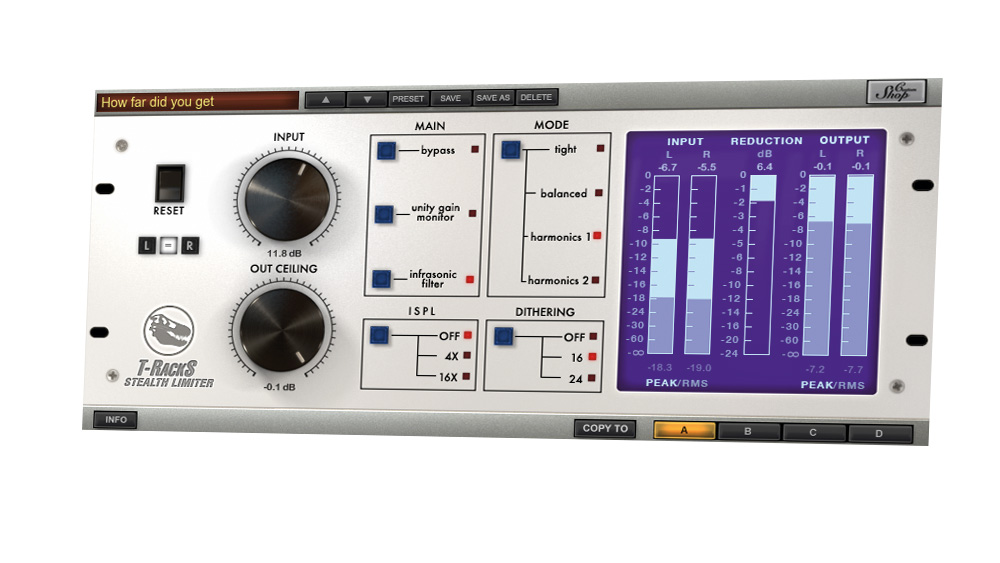MusicRadar Verdict
An excellent four-mode limiter that covers a range of uses, marred slightly by bloody- minded controls and basic metering.
Pros
- +
Simple operation. Four modes for a choice of sounds. Intersample peak limiting. Two oversampling rates.
Cons
- -
Cycling parameter settings are needlessly irritating. Could benefit from more metering.
MusicRadar's got your back
Stealth Limiter (VST/AU/RTAS/AAX/Standalone) is the latest addition to IK Multimedia's T-RackS system, available via the T-RackS Custom Shop or direct from IK's site.
It can be used within T-RackS for standalone operation or building self-contained plugin chains within a host but also comes as a regular plugin, which is more convenient for DAW use.
The interface is refreshingly straightforward, centring on just two knobs: Input (0dB to +20dB) and Ceiling (0dB to -20dB). The metering is also very simple, with a gain reduction meter flanked by input and output meters indicating both peak and RMS levels. That's it for metering options, and the meter scale can't be adjusted, which is sure to raise a few eyebrows.
The rest of Stealth Limiter's settings are laid out across four central panels: Main, Mode, ISPL (Intersample Peak Limiter) and Dithering. The Mode, ISPL and Dithering sections' single buttons cycle through the available options (again, this won't be everyone's cup of tea), while the three buttons in the Main panel directly select their respective settings - a strange inconsistency.
The four Modes select the core algorithm at work behind the scenes, and range from ultra- transparent (Tight) and moderate compression (Balanced), to valve (Harmonics 1) and solid- state (Harmonics 2) saturation.
The Main panel also houses the Infrasonic Filter - a 22Hz high- pass filter for removing unwanted sub frequencies - and the Unity Gain Monitor option, which compensates for the gain applied at the Input and lets you make gain-consistent comparisons between your processed and unprocessed signals using the Bypass button.
At the bottom, the Intersample Peak Limiter is activated by selecting one of two oversampled rates (x4 and x16), while Dithering applies 24-bit or 16-bit dither noise.
Loud and proud
Stealth Limiter's first two Modes, Tight and Balanced, are indistinguishable at lower levels, while Harmonics 1 and 2 both introduce more obvious saturation. The Harmonics options are good for adding favourable colour to submixes, for example, and we found, to our surprise, that we preferred Harmonics 2 (solid state).
Nonetheless, when you start to push it hard, aiming for a loud master with minimal obvious distortion, it's definitely the cleanest option, Tight, that you want, and the simple control set lets you focus on listening and picking the exact level, rather than fiddling with parameters.
IK boasts that Stealth Limiter is the most transparent, clear and loud software mastering peak limiter available, which is quite a claim, but also, of course, totally subjective. We pitted it against some of the most highly regarded true peak limiters available, including models by iZotope, Flux and FabFilter.
Not all of these provide automatic intersample adjustment, so Stealth is straightforward in that respect, and for maximum loudness with minimum distortion, it ranked in the top three of the range we tested. The only snag is the massive CPU hit with the x16 ISPL option - a x8 setting would be more workable for most users.
Stealth Limiter is certainly a fine limiter, with a streamlined but capable feature set. If it had more in the way of metering options and less fiddly selectors, it may well have scored full marks. Roll on v1.1, we say!
Computer Music magazine is the world’s best selling publication dedicated solely to making great music with your Mac or PC computer. Each issue it brings its lucky readers the best in cutting-edge tutorials, need-to-know, expert software reviews and even all the tools you actually need to make great music today, courtesy of our legendary CM Plugin Suite.
“A synthesizer that is both easy to use and fun to play whilst maintaining a decent degree of programming depth and flexibility”: PWM Mantis review
“I feel like that song had everything we needed to come back with”: Bring Me The Horizon’s Lee Malia on Shadow Moses, its riff and the secrets behind its tone, and why it was the right anthem at the right time
“I said, ‘Are we sure we can write a song about death?’”: The story of Mike + The Mechanics' classic No.1 The Living Years











